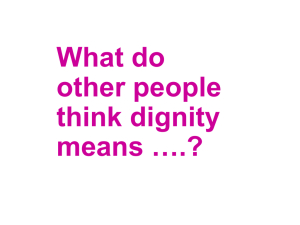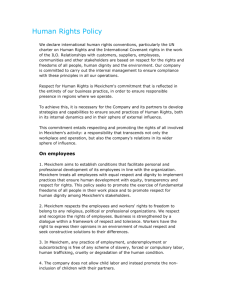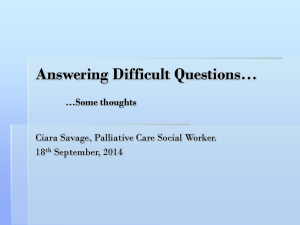Human Dignity - All Australian Essays
advertisement
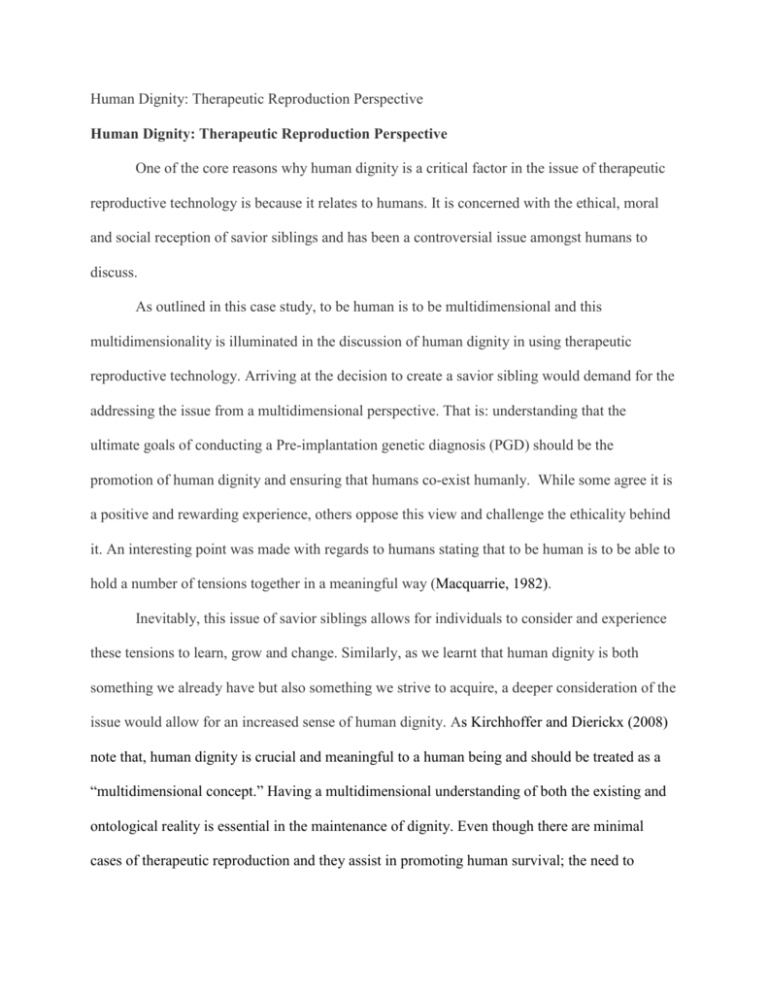
Human Dignity: Therapeutic Reproduction Perspective Human Dignity: Therapeutic Reproduction Perspective One of the core reasons why human dignity is a critical factor in the issue of therapeutic reproductive technology is because it relates to humans. It is concerned with the ethical, moral and social reception of savior siblings and has been a controversial issue amongst humans to discuss. As outlined in this case study, to be human is to be multidimensional and this multidimensionality is illuminated in the discussion of human dignity in using therapeutic reproductive technology. Arriving at the decision to create a savior sibling would demand for the addressing the issue from a multidimensional perspective. That is: understanding that the ultimate goals of conducting a Pre-implantation genetic diagnosis (PGD) should be the promotion of human dignity and ensuring that humans co-exist humanly. While some agree it is a positive and rewarding experience, others oppose this view and challenge the ethicality behind it. An interesting point was made with regards to humans stating that to be human is to be able to hold a number of tensions together in a meaningful way (Macquarrie, 1982). Inevitably, this issue of savior siblings allows for individuals to consider and experience these tensions to learn, grow and change. Similarly, as we learnt that human dignity is both something we already have but also something we strive to acquire, a deeper consideration of the issue would allow for an increased sense of human dignity. As Kirchhoffer and Dierickx (2008) note that, human dignity is crucial and meaningful to a human being and should be treated as a “multidimensional concept.” Having a multidimensional understanding of both the existing and ontological reality is essential in the maintenance of dignity. Even though there are minimal cases of therapeutic reproduction and they assist in promoting human survival; the need to Human Dignity: Therapeutic Reproduction 2 maintain the human dignity as well as the freedom of beings to make their choice is critical while making a PGD decision. Perspective 1: Therapeutic reproductive technology upholds human dignity only insofar as it allows for the autonomous decision making of both the savior sibling and their ill sibling. Human being deserves dignity can be acquired through moral behavior. As the savior sibling it is morally justified to sacrifice oneself to help save another sibling, a human being. Therefore, saving another human life conveys respect for human dignity. In addition, if this kind of action is taken based on autonomous decisions, human dignity is preserved. Human dignity and autonomous are key principles needed during the therapeutic reproduction process. While upholding this, every human being is morally obliged sacrifice and undergoes a transplantation process to save a life of another. Saving a life (in this case of an ailing sibling) needs to be practiced in a morally fashion considering all the ethical issues attributable to the process. As pointed by Macquarrie (1982) although the term ‘human’ is ambiguous, it has an expression of “making and keeping human life human.” The need to minds other human beings concerns is a way of upholding dignity. Advancement of medical technology has indeed assisted in saving more human life. The use of IVF test technique to identify the best and matching embryo to save a sibling is upholding dignity. Contrary, improved technology may hinder autonomy as well as the success of a therapeutic process. Since autonomy is much respected, as long as each individual’s autonomous decision making is allowed, therapeutic reproductive technology should encourage the consent of both parties involved. This will give the savior sibling a chance to choose whether to ‘save’ the live of the ailing sibling. In this case, human dignity will be upheld. For instance, in the case of Human Dignity: Therapeutic Reproduction 3 Jamie and Charlie, ‘savior sibling’ (Jamie) had even to think that he was just ‘born’ to be a ‘medical’ cure to his brother. Human dignity is only preserved where autonomy and consent is upheld. In the case of Jamie and Charlie, Jamie was not just born to be a medical cure to his brother. From the time their parents first met in 1989, they wanted a large family of five children. By the time they decided to conceive Jamie using IVF, they already had two children. They were bound to have three more children, and there was a high probability that another son would be born. There was also a high probability that the son would suffer from a genetic condition just like Charlie (Levin, 2011). Resorting to Pre-Genetic Diagnosis was a manifestation of the parents’ respect for human dignity since they would have a son who would have the necessary stem cells to save the life of their elder son. They would also be ensuring that their unborn son would have the dignity of enjoying a healthy life since PGD would eliminate any chance of a genetic disorder. Under the legal framework in many Common Wealth countries, children under the age of eighteen years are regarded as minors, and they do not have the capacity to consent to legal and medical procedures. Parents have the legal and moral right to exercise the right to consent and autonomy on behalf of their children (Do Carmo, 2013). When parents consent to a procedure, they act on behalf of their children who do not have the mental or legal capacity to consent. Therapeutic reproduction technologies promote human dignity in cases where there is the parental consent of both parents. Human dignity would only be said to be abused when parents oppose therapeutic reproduction technology, but medical officers go ahead with the procedure without the consent of the parents. In the case of Charlie and Jamie, for instance, Charlie was under the age of five while Jamie was only one year old when the procedures were performed. If Charlie’s parents waited Human Dignity: Therapeutic Reproduction 4 until he was old enough to give individual consent, he would either have died, or he would have had to spend the rest of his life under transfusions and medications (Levin, 2011). Exposing Charlie to endless suffering, which could have been terminated through a medical procedure, would have been a violation of his human dignity. Parental consent in therapeutic reproduction technology is an indisputable hallmark of human dignity. Evaluation of the consequences of adopting this perspective in isolation is that it fails to put into consideration the feelings the savior sibling and the sick sibling will have in their adult years. Perspective 3: Therapeutic reproductive technology undermines the inherent dignity of the human person because it relies on scientific selection of embryos and hence commodifies the human persons. Some of the behaviors such as discarding embryos which do not match with the doctor’s or parent’s intent are immoral behavior. For instance, as the Life organization spokesman noted, “Adam was the fifteenth embryo created which meant fourteen people were killed before him,” (BBC NEWS, Health, 2000). The behavior only justifies being effective to the ailing sibling but optional to the savior sibling. Due to the advancement in medical technology, doctors have been intervening with the human dignity especially when they claim to ‘create’ a human being through Pre-implantation genetic diagnosis (PGD) process whereby exact tissue matches is tested (Do Carmo,2013). This makes other human beings to be like ‘practical humans’ and undermines the creation objective. Scientific selection of embryos has been criticized extensively on ethical basis due to allegations that it results in the creation of designer babies as doctors take over the role of the creator. PGD is criticized extensively because it has become a multibillion dollar business. It faces limitations in countries such as France and England, and complete prohibition in countries Human Dignity: Therapeutic Reproduction 5 such as Germany and Italy. Most couples have been travelling to the United States where there are no extensive legal restrictions. PGD was initially meant for noble purposes such as making sure that children did not suffer from genetic illnesses inherited from their parents. However, over time PGD has been abused and used for practices that abuse the concept of human dignity such as sex selection and selection of a horde of other superficial character traits (Do Carmo, 2013). The initial purposes of PGD which were to screen embryos for mutations and inherited diseases showed respect for human dignity. The use Of PGD to screen for characteristics such as eye color, hair color, or the sex child abuses the inherent dignity of human beings since it implies that children of a particular sex, particular hair or eye color are superior to other children. The issue of whether therapeutic reproduction in cases of creation of savior siblings promotes or abuses human dignity is debatable. The idea appears to be noble when it is done to save the life of a dying sibling. It however raises ethical issues such as the quality of life that will be led by the savior child. This is because the process commodifies the savior child by turning him into a consumer good that can be used and purchased. The human dignity of the savior child is particularly compromised in cases where he or she has to spend several periods in hospital undergoing medical procedures for the benefit of his or her sibling (Levin, 2011). The process also affects the self worth of the siblings who are not involved in the process. In the case of Jamie and Charlie, their sister felt unworthy because she could not help to save her brother’s life. PGD arrangements may thus ruin the self-worth and self-esteem of the entire family (Kirchhoffer & Dierickx, 2008). Everyone involved in the process, including the doctors may feel undignified. Evaluation of the consequences of adopting this perspective in isolation is that it does not pout in consideration the chronic consequences of failing to save the life of the sick sibling. Human Dignity: Therapeutic Reproduction 6 Multidimensional of human dignity According to Kirchhoffer and Dierickx (2008), “all humans have dignity …all humans also seek to acquire dignity.” For this reason, a multidimensional approach coupled with mutual understanding is regarded essential especially when conducting therapeutic reproduction. Understanding human dignity in a multidimensional perspective will definitely be useful in the protection of the person’s inherent potential as well as realizing the self worthiness of individuals and their development. Human dignity is inherent, in that one gets it by virtue of being born human. Religiously, people believe that God creates every human being with a purpose to fulfill in the universe. Human dignity should be viewed from a multi-dimensional perspective because it is not a mono-dimensional phenomenon. Taking into account one understanding or perception is dangerous since it ignores the benefits of other perspectives. The critical issue of therapeutic reproduction technology requires a multidimensional approach since there is no single perception that is right or appropriate. The first quadrant of human dignity states that humans are born with dignity by virtue of belonging to the human species. The second quadrant suggests that human beings can lose or acquire dignity through their sense of self-worth. The third quadrant states that human dignity acquire dignity based in their possession of human capacities while other fourth quadrant premises that dignity is acquired or lost through moral or immoral behavior (Macquarrie, 1981). None of the four quadrants is completely right or completely wrong. The four quadrants only make logical sense when they are evaluated holistically. Similarly, the two perspectives on therapeutic reproduction technologies discussed above are only rational when they are evaluated from a multi-dimensional perspective. Even though therapeutic technologies promote human dignity when parental consent is given to save the life of a surviving sibling it’s also important to consider the feelings of self Human Dignity: Therapeutic Reproduction 7 worth that the sick child, the savoir child, and other siblings will have about the procedure when they become autonomous human beings. Conclusion Human dignity is a critical factor in the case study on savior siblings since it affects the self-worth of all the people involved in the process including doctors, parents and the siblings. The first perspective stresses on the importance of autonomy and consent as the basis for conducting therapeutic reproductive technologies in a manner that promotes human dignity. The second perspective explores ways through which therapeutic technologies undermine human dignity since the scientific selection of embryos commodifies human beings. The weaknesses of the two perspectives create the need for a multidimensional approach of human dignity. The multidimensional is important as it weighs the advantages and disadvantages of each perspective, and it enables a person to reach a decision to use PGD in cases when the procedure more benefits than disadvantages for all the parties involved. Human Dignity: Therapeutic Reproduction 8 References BBC NEWS, (2000). Baby created to save older sister. Health, 4th October. Retrieved January 25, 2014 from: http://news.bbc.co.uk/2/hi/health/954408.stm Do Carmo, M. (2013). Child Autonomy and Rights to One’s Own Body: PGD and Parental Decision Making. Retrieved January 25, 2014 from: http://www.thebioethicsproject.org/essays/child-autonomy-and-the-rights-to-ones-ownbody-pgd-and-parental-decision-making/ Kirchhoffer, D.G. & Dierickx, K. (2008). Human dignity and human tissue: a meaningful ethical relationship. Journal of Medical Ethics, 37: 552-556. Levin, A (2011). I Knew I was Born to Save Charlie Instead of Being Born Just for Me. Mail Online. Macquarrie, J. (1982), Becoming. In Search of Humanity, 1-9. London: SCM,
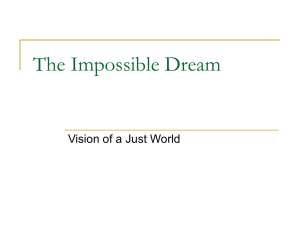
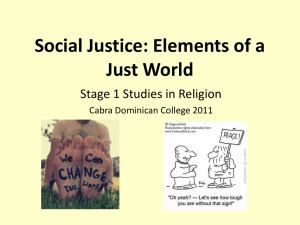
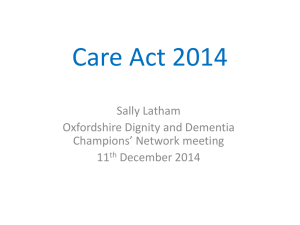
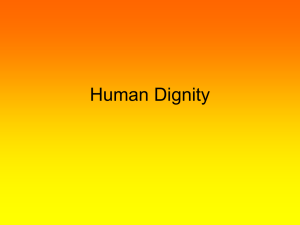

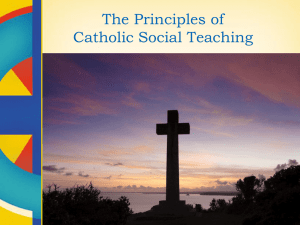
![4[1]._a_man_as_a_person](http://s2.studylib.net/store/data/005226893_1-b67b2be2c3623c1c44b6baa80b997c62-300x300.png)
